De Havilland Canada Dash 8
The De Havilland Canada DHC-8,[4] commonly known as the Dash 8, is a series of turboprop-powered regional airliners, introduced by de Havilland Canada (DHC) in 1984. DHC was later bought by Boeing in 1988, then by Bombardier in 1992; then by Longview Aviation Capital in 2019, reviving the de Havilland Canada brand. Powered by two Pratt & Whitney Canada PW100s, it was developed from the Dash 7 with improved cruise performance and lower operational costs, but without STOL performance. Three sizes were offered: initially the 37–40 seat -100 until 2005 and the more powerful -200 from 1995, the stretched 50–56 seats -300 from 1989, both until 2009, and the 68–90 seats -400 from 1999, still in production. The Q Series are post-1997 variants fitted with active noise control systems.
| Dash 8 Q-Series | |
|---|---|
.jpg) | |
| Air Berlin Q400 | |
| Role | Turboprop regional airliner |
| Manufacturer |
|
| First flight | June 20, 1983 |
| Introduction | 1984 with NorOntair |
| Status | In production |
| Primary users | Jazz |
| Produced | 1983–present |
| Number built | 1,249 (as of June 30, 2018)[1] |
| Unit cost | |
| Developed from | de Havilland Canada Dash 7 |
Development
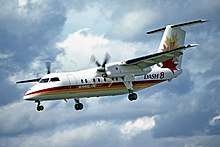
In the 1970s, de Havilland Canada had invested heavily in its Dash 7 project, concentrating on STOL and short-field performance, the company's traditional area of expertise. Using four medium-power engines with large, four-bladed propellers resulted in comparatively lower noise levels, which combined with its excellent STOL characteristics, made the Dash 7 suitable for operating from small in-city airports, a market DHC felt would be compelling. However, only a handful of air carriers employed the Dash 7, as most regional airlines were more interested in operational costs than short-field performance.
In 1980, de Havilland responded by dropping the short-field performance requirement and adapting the basic Dash 7 layout to use only two, more powerful engines. Its favoured engine supplier, Pratt & Whitney Canada, developed the new PW100 series engines for the role, more than doubling the power from its PT6. Originally designated the PT7A-2R engine, it later became the PW120. When the Dash 8 rolled out on April 19, 1983, more than 3,800 hours of testing had been accumulated over two years on five PW100 series test engines. The Dash 8 first flight was on June 20, 1983.
Certification of the PW120 followed on December 16, 1983.[5]
Service introduction
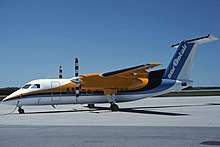
The airliner entered service in 1984 with NorOntair, and Piedmont Airlines, formerly Henson Airlines, was the first US customer the same year.
The Dash 8 was introduced at a particularly advantageous time; most airlines were in the process of adding new aircraft to their fleets as the airline industry expanded greatly in the 1980s. The older generation of regional airliners from the 1950s and 1960s was nearing retirement, leading to high sales figures. De Havilland Canada was unable to meet the demand with sufficient production.
DHC resale
In 1986, Boeing bought the company in a bid to improve production at DHC's Downsview Airport plants,[6] as well as better position itself to compete for a new Air Canada order for large intercontinental airliners. Air Canada was a crown corporation at the time, and both Boeing and Airbus were competing heavily via political channels for the contract. It was eventually won by Airbus, which received an order for 34 A320 aircraft in a highly controversial move. The allegations of bribery are today known as the Airbus affair. Following its failure in the competition, Boeing immediately put de Havilland Canada up for sale. The company was eventually purchased by Bombardier in 1992.[7]
Q-Series, -400
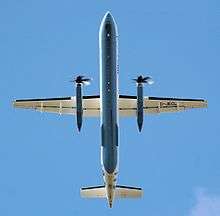
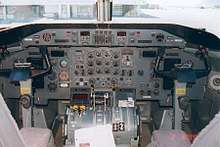
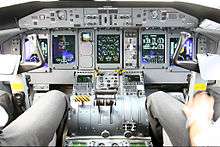
The market for new aircraft to replace existing turboprops once again grew in the mid-1990s, and DHC responded with the improved "Series 400" design.
All Dash 8s delivered from the second quarter of 1996 (including all Series 400s) include the Active Noise and Vibration System designed to reduce cabin noise and vibration levels to nearly those of jet airliners. To emphasize their quietness, Bombardier renamed the Dash 8 models as the Q-Series turboprops (Q200, Q300, and Q400).[8]
The last Dash 8–100, a –102, was built in 2005.
In April 2008, Bombardier announced that production of the classic versions (Series 100, 200, 300) would be ended, leaving the Series 400 as the only Dash 8 still in production.
Production of the Q200 and Q300 was to cease in May 2009.[9]
A total of 671 Dash 8 classics were produced; the last one was delivered to Air Nelson in May 2008.[10] The 1,000th Dash 8 was delivered in November 2010.[11]
Production
Bombardier aimed to produce the Q400 more economically. A deal with its machinists union in June 2017 allowed the assembly of the wings and cockpit section outside Canada and searches for potential partners commenced. Bombardier expected to produce the cockpit section in its plant in Queretaro, Mexico, outsourcing the wings to China's Shenyang Aircraft Corp, which already builds the Q400's centre fuselage.[12] The Q400 components are chemically milled while older variants are assembled from bonded panels and skins.[13]
Proposed Q400X stretch
Bombardier proposed development of a Q400 stretch with two plug-in segments, called the Q400X project, in 2007.[14] It would compete in the 90-seat market range.[15] In response to this project, as of November 2007, ATR was studying a 90-seat stretch.[16]
In June 2009, Bombardier commercial aircraft president Gary Scott indicated that the Q400X will be "definitely part of our future" for possible introduction in 2013–14, although he did not detail the size of the proposed version or commit to an introduction date.[17]
As of July 2010, Bombardier's vice president, Phillipe Poutissou, made comments explaining the company was still studying the prospects of designing the Q400X and talking with potential customers. At the time, Bombardier was not as committed to the Q400X as it had been previously.[18] As of May 2011, Bombardier was still strongly committed to the stretch, but envisioned it as more likely as a 2015 or later launch, complicating launch date matters were new powerplants from GE and PWC to be introduced in 2016.[19] As of February 2012, Bombardier was still studying the issue, but as of 2011, the launch date was no longer targeted for the 2014 range. At least a three-year delay was envisioned.[20]
In October 2012, a joint development deal with a government-led South Korean consortium was revealed, to develop a 90-seater turboprop regional airliner, targeting a 2019 launch date. The consortium was to have included Korea Aerospace Industries and Korean Air Lines.[21]
High-density, 90-seat Q400
At the February 2016 Singapore Airshow, Bombardier announced a high-density, 90-seat layout of the Q400, which should enter service in 2018; keeping the 28 in (71 cm) seat pitch of the Nok Air 86-seats, an extra row of seats is allowed by changing the configuration of the front right door and moving back the aft pressure bulkhead. The payload is increased by 2,000 pounds (910 kg) and the aircraft maintenance check intervals are increased: 800 hours from 600 for an A-check and 8,000 hours from 6,000 for a C-check.[22] By August 2018, the 90-seat variant was certified before delivery to launch customer SpiceJet later in the same year.[23]
Sale to Longview, reviving the De Havilland Canada name
On November 8, 2018, Viking Air parent Longview Aviation Capital Corporation acquired the entire Dash 8 program and the de Havilland brand from Bombardier, in a deal that would close by the second half of 2019.[24] Viking had already acquired the discontinued de Havilland Canada aircraft model type certificates in 2006.[25]
By November 2018 the sales of the higher-performance Q400 were slower than the cheaper ATR Aircraft.[26] Bombardier announced the sale was for $300 million and expects $250 million net.[27] The sale will result in $250 million annual savings. Bombardier also sold its business jet training program to CAE Inc. for $645 million and announced 5,000 job cuts over 18 months within 70,000 employees worldwide: 500 within 6,500 in Ontario, 2,500 in Quebec and 2,000 outside Canada.[28]
In January 2019, Longview announced that it would establish a new company in Ontario, reviving the de Havilland Aircraft Company of Canada name, to continue production of the Q400 and support the Dash 8 range.[29] By February, the program sale was expected to close at the end of September.[30]
On June 3, 2019, the sale was closed with the newly formed De Havilland Canada (DHC) taking control of the Dash 8 program, including the previous -100, -200, and -300 series. Production of the Q400 is currently planned to continue at the Downsview production facility, under DHC's management.[31] De Havilland is considering a 50-seat shrink, as North American airlines operate 870 ageing 50-seaters, mostly CRJs and Embraer ERJs.[32]
Design
_(11473432873).jpg)
Distinguishing features of the Dash 8 design are the large T-tail intended to keep the tail free of prop wash during takeoff, a very high aspect ratio wing, the elongated engine nacelles also holding the rearward-folding landing gear, and the pointed nose profile.
The Dash 8 design has better cruise performance than the Dash 7, is less expensive to operate, and is much less expensive to maintain, due largely to having only two engines. It is a little noisier than the Dash 7 and cannot match the STOL performance of its earlier DHC forebears, although it is still able to operate from small airports with runways 3,000 ft (910 m) long, compared to the 2,200 ft (670 m) required by a fully laden Dash 7.
Regional jet competition
The introduction of the regional jet altered the sales picture. Although more expensive than turboprops, regional jets allow airlines to operate passenger services on routes not suitable for turboprops. Turboprop aircraft have lower fuel consumption and can operate from shorter runways than regional jets, but have higher engine maintenance costs, shorter ranges, and lower cruising speeds.[33]
When world oil prices drove up short-haul airfares in 2006, an increasing number of airlines that had bought regional jets began to reassess turboprop regional airliners, which use about 30–60% less fuel than regional jets. Although the market was not as robust as in the 1980s when the first Dash 8s were introduced, 2007 had increased sales of the only two 40+ seat regional turboprops still in western production, Bombardier's Q400 and its competitor, the ATR series of 50– to 70-seat turboprops. The Q400 has a cruising speed close to that of most regional jets, and its mature engines and systems require less frequent maintenance, reducing its disadvantage.[34]
As the Q400's 360-knot (414-mph, 667-km/h) cruise speed[35] approaches jet speeds, short-haul airlines can usually replace a regional jet with a Q400 without changing their gate-to-gate schedules. Most short-haul routes are less than 350 miles (500 km), so the time spent on taxiing, taking off, and landing virtually eliminates a competing jet's speed advantage.
Marketing
According to Bombardier marketing, the aircraft breaks even with about a third of its seats filled (or a quarter with more closely spaced seats), making it particularly attractive on routes with varying passenger numbers where many seats would be empty on some flights. For example, Island Air in Hawaii calculated that the use of a 50-seat regional jet would break even at 45 passenger seats compared to the Q400's 35–36 seats (around 55% breakeven load factor).
In 2013, Bombardier was singling out the Q400 for more aggressive marketing, having launched a website centered around the aircraft.[36]
Variants
The aircraft has been delivered in four series. The Series 100 has a maximum capacity of 39, the Series 200 has the same capacity but offers more powerful engines, the Series 300 is a stretched, 50-seat version, and the Series 400 is further stretched to 90[37] passengers. Models delivered after 1997 have cabin noise suppression and are designated with the prefix "Q".[38] Production of the Series 100 ceased in 2005, followed by the 200 and 300 in 2009, leaving the Q400 as the only series still in production.
Series 100
.jpg)
The Series 100 was the original 37- to 39-passenger version of the Dash 8 that entered service in 1984. The original engine was the Pratt & Whitney Canada PW120 and later units used the PW121. Rated engine power is 1,800 shp (1,340 kW).
- DHC-8-101
- 1984 variant powered by either two PW120 or PW120A engines and a 33,000 lb (15,000 kg) takeoff weight.
- DHC-8-102
- 1986 variant powered by either two PW120A or PW121 engines and a 34,500 lb (15,650 kg) takeoff weight.
- DHC-8-103
- 1987 variant powered by two PW121 engines and a 34,500 lb (15,650 kg) takeoff weight (can be modified for a 35,200 lb [15,950 kg] take-off weight)
- DHC-8-102A
- 1990 variant powered by two PW120A engines with revised Heath Tecna interior.
- DHC-8-106
- 1992 variant powered by two PW121 engines and a 36,300 lb (16,450 kg) takeoff weight.
- DHC-8-100PF
- DHC-8-100 converted to a freighter by Voyageur Aviation, with a 10,000 lb (4,536 kg) cargo capacity.[39]
- DHC-8M-100
- Two aircraft for Maritime Pollution Surveillance, operated by Transport Canada, equipped with the MSS 6000 Surveillance system.[40]
- CC-142
- Military transport version for the Canadian Forces in Europe.
- CT-142
- Military navigation training version for the Canadian Forces. Used to train Canadian and allied nation's ACSOs and AESOPs [41]
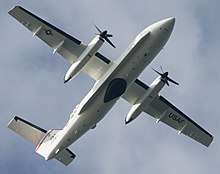
- E-9A Widget
- A United States Air Force range control aircraft that ensures that the overwater military ranges in the Gulf of Mexico are clear of civilian boats and aircraft during live fire tests of air-launched missiles and other hazardous military activities.[42] The E-9A Widget is equipped with AN/APS-143(V)-1 radar that can detect an object in the water as small as a person in a life raft, from up to 25 miles away.[43] Aircraft operates out of Tyndall Air Force Base, Florida with two aircraft assigned to the 82d Aerial Targets Squadron for the support of training missions.
Series 200
The Series 200 aircraft maintained the same 37–39 passenger airframe as the original Series 100, but was re-engined for improved performance. The Series 200 used the more powerful Pratt & Whitney Canada PW123 engines rated at 2,150 shp (1,600 kW).
- DHC-8-201
- 1995 variant powered by two PW123C engines.
- DHC-8-202
- 1995 variant powered by two PW123D engines.
- Q200
- Version of the DHC-8-200 with the ANVS (Active Noise and Vibration Suppression) system.
Series 300
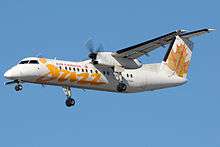
The Series 300 introduced a longer airframe that was stretched 3.43 metres (11.3 ft) over the Series 100/200 and has a passenger capacity of 50–56. The Series 300 also used the Pratt & Whitney Canada PW123 engines. Rated engine power is between 2,380 shp (1,774 kW) and 2,500 shp (1,864 kW). Design service life is 80,000 flight cycles. Under an extended service program launched in 2017, the service life of Dash 8-300 is extended by 50 per cent, or approximately 15 years, to 120,000 flight cycles.[44]
- DHC-8-301
- 1989 variant powered by two PW123 engines
- DHC-8-311
- 1990 variant powered by two PW123A engines with revised Heath Tecna interior. In addition, the landing gear design changed to a slightly swept back design intended to prevent tail strikes.
- DHC-8-314
- 1992 variant powered by two PW123B engines
- DHC-8-315
- 1995 variant powered by two PW123E engines
- DHC-8-300A
- Version of the DHC-8-300 with increased payload.
- Q300
- Version of the DHC-8-300 with the ANVS (Active Noise and Vibration Suppression) system.
- DHC-8-300 MSA
- Upgraded variant with L-3 for maritime surveillance platform.
- RO-6A
- United States military designation for the DHC-8-315 for the United States Army as a reconnaissance platform.
- C-147A
- United States military designation for the DHC-8-315 for the United States Army as a jump platform [45]
Series 400
.jpg)
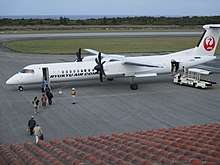
The Series 400 introduced an even longer airframe that was stretched 6.83 metres (22.4 ft) over the Series 300 (10.26 metres (33.7 ft) over the Series 100/200), has a larger, stouter T-tail and has a passenger capacity of 68–90. The Series 400 uses Pratt & Whitney Canada PW150A engines rated at 4,850 shp (3,620 kW). The aircraft has a cruise speed of 360 knots (667 km/h), which is 60–90 knots (111–166 km/h) higher than its predecessors. The maximum operating altitude is 25,000 ft (7,600 m) for the standard version, although a version with drop-down oxygen masks is offered, which increases maximum operating altitude to 27,000 ft (8,200 m).
Between its service entry in 2000 and the 2018 sale to Longview/Viking, 585 have been delivered at a rate of 30-35 per year, leaving a backlog of 65, for a market value at a stable level of $21 million new.[46]
- DHC-8-400
- 1999 variant with a maximum of 68 passengers.
- DHC-8-401
- 1999 variant with a maximum of 70 passengers.
- DHC-8-402
- 1999 variant with a maximum of 78 passengers.
- Q400
- Stretched and improved 70–78 passenger version that entered service in 2000. All Q400s include the ANVS (Active Noise and Vibration Suppression) system.
- Q400NextGen
- Version of the Q400 with updated cabins, lighting, windows, overhead bins, landing gear, as well as reduced fuel and maintenance costs.
- In 2013, an Extra Capacity variant was introduced, capable of carrying a maximum of 86 passengers.[47] The Extra Capacity variant was updated in 2016 with more closely spaced seats to carry up to 90 passengers.[48] The first 90-seat aircraft was delivered to launch customer SpiceJet in September 2018.[49]
- Q400-MR
- Two Q400 aircraft adapted to the water bombing role as aerial firefighting air tankers by Cascade Aerospace for the French Sécurité Civile.[50] This tanker can carry 2,600 US gallons (9,800 l) of retardant, foam or water and travel at 340 knots (630 km/h).
- DHC-8 MPA-D8
- 2007 converted for use as a maritime patrol aircraft.
- DHC-8-402PF
- 2008 converted pallet freighter variant with a payload of 9000 kg.
- Q400CC
- Cargo combi. Seats 50 passengers plus 3720kg (8200 lb) of payload. First delivered to launch customer Ryukyu Air Commuter in 2015.
Operators
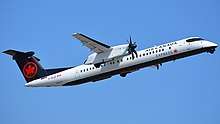
By 2017, the Q400 aircraft had logged 7 million flight hours with 60 operators and transported over 400 million passengers with a dispatch reliability over 99.5%.[51]
By July 2018, 844 Dash 8s were in airline service: 143 Series 100 with 35 operators, 42 Series 200 with 16 operators, 151 Series 300 with 32 operators and 508 Q400s.[52] By then, 56 orders were in backlog.[53]
Orders and deliveries
| Model Series | Orders | Deliveries | Unfilled |
|---|---|---|---|
| Series 100 | 299 | 299 | – |
| Series 200 | 105 | 105 | – |
| Series 300 | 267 | 267 | – |
| Series 400 | 645 | 587 | 58 |
| Total | 1,316 | 1,258 | 58 |
Accidents and incidents
The DHC-8 has been involved in 80 aviation accidents and incidents including 31 hull losses.[55] Those resulted in 180 fatalities.[56]
Accidents with fatalities
| Date | Type | Flight | Fat. | Surv. | Location | Circumstances |
|---|---|---|---|---|---|---|
| Nov 21, 1990 | -100 | Bangkok Airways Flight 125 | 38 | 0 | Thailand Koh Samui |
Crashed while attempting to land in heavy rain and high winds.[58] |
| Jan 6, 1993 | -300 | Lufthansa Cityline 5634 op. for Contact Air | 4 | 19 | France Paris-CDG Airport |
Crashed short of the runway.[59] |
| Jun 9, 1995 | -100 | Ansett New Zealand 703 | 4 | 17 | New Zealand, near Palmerston North Airport |
During an instrument approach in inclement weather, the aircraft crashed on the western slopes of the Tararua Ranges. |
| Feb 12, 2009 | -400 | Colgan Air 3407 op. for Continental Connection | 49 + 1 | 0 | United States, New York, Clarence Center |
While approaching Buffalo Niagara Airport, the aircraft stalled and crashed into a house due to pilot error.[60] |
| Oct 13, 2011 | -100 | Airlines PNG 1600 | 28 | 4 | Papua New Guinea near Madang Airport |
Crashed and subsequently ignited, due to pilot error.[61] |
| Oct 5, 2013 | -200 | USAF patrol flight | 4 | 2 | Colombia near Acandí |
A military surveillance plane crashed while being operated on a maritime counter-drug patrol mission[62] |
| Mar 12, 2018 | -400 | US-Bangla Airlines 211 | 51 | 20 | Nepal Kathmandu Airport |
Crashed on landing due to pilot error. Deadliest Dash 8 crash to date.[63][64] |
| Aug 10, 2018 | -400 | 2018 Horizon Air Q400 incident | 1 | 0 | USA, Washington, Ketron Island |
No passengers on board, stolen from Seattle–Tacoma Airport by a ground employee and deliberately crashed, killing himself.[65] |
Hull losses
- April 15, 1988: Horizon Air Flight 2658, operated by DHC-8-102 N819PH suffered an engine fire on climb-out from Seattle/Tacoma International Airport. An emergency landing was made but the aircraft struck equipment on the ground before crashing into two jetways. N819PH was destroyed by fire; there were no fatalities.[66]
- November 23, 2009: a DHC-8-200, being operated on behalf of United States Africa Command, made an emergency landing at Tarakigné, Mali and was substantially damaged when the undercarriage collapsed and the starboard wing was ripped off. The accident was caused by the aircraft running out of fuel 29 seconds before the crash. The captain had opted not to refuel at the previous departure airport.[67]
- April 9, 2012: Air Tanzania Dash 8 5H-MWG was written off at Kigoma Airport, Tanzania in an aborted take off. All 39 people on board survived.[68]
- September 30, 2015: Luxair Flight 9562 experienced an aborted takeoff accident at Saarbrücken Airport in Germany. The Bombardier Q400 LX-LGH was damaged beyond repair when it settled back onto the runway after the gear was raised prematurely. The aircraft slid 2,400 feet and came to a stop with more than 1,100 feet remaining of the 6,562 foot paved runway. None of the 20 occupants were injured.[69][70]
- May 8, 2019: Biman Bangladesh Airlines Flight 60, a Dash-8 Q400 slid off Runway 21 at Yangon International Airport, Burma, and broke into three pieces as it performed a go-around on landing. The flight originated in Dhaka, Bangladesh. Poor weather was cited as a contributing factor. At least 17 people were injured.[71][72]
Major landing gear accidents

In September 2007, two separate accidents of similar landing gear failures occurred within four days of each other on Scandinavian Airlines (SAS) Dash 8-Q400 aircraft. A third accident occurred in October 2007, leading to the withdrawal of the type from the airline's fleet.
On September 9, 2007, the crew of SAS Flight 1209, en route from Copenhagen to Aalborg, reported problems with the locking mechanism of the right side landing gear, and Aalborg Airport was prepared for an emergency landing. Shortly after touchdown the right main gear collapsed and the airliner skidded off the runway while fragments of the right propeller shot against the cabin and the right engine caught fire. Of 69 passengers and four crew on board, 11 were sent to hospital, five with minor injuries.[73][74][75] The accident was filmed by a local news channel (TV2-Nord) and broadcast live on national television.
Three days later on September 12, Scandinavian Airlines Flight 2748 from Copenhagen to Palanga had a similar problem with the landing gear, forcing the aircraft to land in Vilnius international airport (Lithuania). No passengers or crew were injured.[76] Immediately after this accident SAS grounded all 33 Q400 airliners in its fleet and, a few hours later, Bombardier recommended that all Q400s with more than 10,000 flights be grounded until further notice.[77] This affected about 60 aircraft, out of 140 Q400s then in service.
On October 27, 2007, Scandinavian Airlines Flight 2867 en route from Bergen to Copenhagen had severe problems with the landing gear during landing in Kastrup Airport. The right wing gear did not deploy properly (or partially), and the aircraft skidded off the runway in a controlled emergency landing. The Q400 was carrying 38 passengers, two infants and four crew members on board. No injuries were reported.[78][79] The next day, SAS permanently removed its entire Dash 8 Q400 fleet from service.[80] In a press release on October 28, 2007, the company's president said: "Confidence in the Q400 has diminished considerably and our customers are becoming increasingly doubtful about flying in this type of aircraft. Accordingly, with the Board of Directors' approval, I have decided to immediately remove Dash 8 Q400 aircraft from service."[78][80][81] The preliminary Danish investigation determined the latest Q400 incident was unrelated to the airline's earlier corrosion problems, in this particular case caused by a misplaced O-ring found blocking the orifice in the restrictor valve.[82]
In all, eight Q400s had landing gear failures while landing during 2007: four in Denmark, one in Germany, one in Japan, one in Lithuania and one in South Korea. In November 2007, it was revealed that the Swedish Civil Aviation Administration had begun an investigation and found Scandinavian Airlines System culpable of cutting corners in its maintenance department. The airline reportedly made 2,300 flights in which safety equipment was not up to standard.[83] On March 10, 2008, SAS ordered 27 more aircraft from Bombardier in a compensation deal: 14 Q400 NextGen turboprops and 13 CRJ900 jets.[84]
On August 19, 2018, a Q400-200 of LC Peru on a flight from Lima to Ayacucho had to return to Lima and make an emergency landing due to a nose gear that could not be lowered. The aircraft landed without the nose gear down.[85]
On November 15, 2018, a Q300-315 belonging to PAL Airlines was unable to lower its nose gear while trying to land at Deer Lake, Newfoundland, diverted to Stephenville, Newfoundland and carried out a nose gear up landing.[86][87]
Specifications
| Model | Q200[88] | Q300[89] | Q400[90] |
|---|---|---|---|
| Cockpit crew | 2 | ||
| Cabin crew | 1 | 1-2 | 2-3 |
| Passengers, typical | 37 | 50@30–33"[91] | 82@30" |
| Max capacity[92] | 40 | 56 | 90@28" |
| Length | 73 ft / 22.25 m | 84 ft 3 in / 25.70 m | 107 ft 9 in / 32.8 m |
| Height | 24 ft 7 in / 7.49 m | 27 ft 5 in / 8.4 m | |
| Wingspan | 85 ft / 25.89 m | 90 ft / 27.4 m | 93 ft 3 in / 28.4 m |
| Wing area | 585 ft² / 54.40 m² | 605 ft² / 56.20 m² | 689 ft² / 64 m² |
| Aspect ratio | 12.32 | 13.36 | 12.6 |
| Width | Fuselage 8 ft 10 in / 2.69 m, cabin 8 ft 3 in / 2.52 m | ||
| Cabin length | 30 ft 1 in / 9.16 m | 41 ft 6 in / 12.60 m | 61 ft 8 in / 18.80 m |
| Max takeoff | 36,300 lb / 16,466 kg | 43,000 lb / 19,505 kg | 67,200 lb / 30,481 kg |
| Operating empty | 23,098 lb / 10,477 kg | 26,000 lb / 11,793 kg | 39284 lb / 17819 kg [93] |
| Max payload | 8,921 lb / 4,647 kg | 13,500 lb / 6,124 kg | 18,716 lb / 8,489 kg |
| Max fuel | 835 U.S. gal / 3,160 L | 1,724 U.S. gal / 6,526 L[94] | |
| Engines | 2 × PW123C/D | 2 × PW123/B/E | 2 × PW150 |
| Unit power | 2,150 hp (1,600 kW) | 2,380–2,500 hp (1,770–1,860 kW) | 5,071 shp / 3,781 kW |
| High speed cruise | 289 kn / 535 km/h | 287 kn / 532 km/h | 300–360 kn / 556–667 km/h |
| Ceiling | 25,000 ft / 7,620 m | 27,000 ft / 8229 m | |
| Range | 1,125 nmi / 2,084 km | 924 nmi / 1,711 km | 1,100 nmi / 2,040 km |
| Takeoff (MTOW, SL, ISA) | 3,280 ft / 1,000 m | 3,870 ft / 1,180 m | 4,675 ft / 1,425 m |
| Landing (MLW, SL) | 2,560 ft / 780 m | 3,415 ft / 1,040 m | 4,230 ft / 1,289 m |
See also
Related development
Aircraft of comparable role, configuration and era
- 29–34 seats
- 42–60 seats
- 64–78 seats
Related lists
- List of airliners
References
Notes
- "Q400 Program Status Report" (PDF). Archived (PDF) from the original on August 27, 2018. Retrieved August 26, 2018.
- Jane's all the world's aircraft. 2005.
- "List Prices - Commercial Aircraft". Bombardier Aerospace. January 2017. Archived from the original on August 15, 2017. Retrieved June 1, 2016.
- "Type Certificate Data Sheet A-142" (PDF). Transport Canada. June 1, 2019. Retrieved September 7, 2019.
- "Type certificate Data Sheet number E-19". Transport Canada. October 20, 2017.
- Burns, John F. (June 15, 1987). "A Boeing Overhaul in Canada". The New York Times. Archived from the original on January 29, 2019. Retrieved January 29, 2019.
- Farnsworth, Clyde H. (January 23, 1992). "Bombardier Agrees to Buy De Havilland From Boeing". The New York Times. Archived from the original on March 4, 2018. Retrieved January 29, 2019.
- Acoustics and Vibration Group (2000). "Paassenger Cabin Noise Comfort Evolution of the Dash-8Q". Canadian Acoustics. 28 (3). Archived from the original on November 15, 2018. Retrieved November 15, 2018.
- "Bombardier to discontinue Q200/Q300 in 2009". Flight Global. April 8, 2008. Archived from the original on April 8, 2015. Retrieved November 14, 2018.
- "Dash 8: Complete list." Archived 2008-12-03 at the Wayback Machine Airfleets.net. Retrieved: December 24, 2009.
- "Bombardier Celebrates Aviation Milestones: 1,000th Dash 8/Q-Series Turboprop and 400th Global Business Jet" (Press release). Bombardier. November 12, 2010. Archived from the original on November 14, 2018. Retrieved November 14, 2018.
- Stephen Trimble (November 13, 2017). "Bombardier still discussing Q400 outsourcing". Flightglobal. Archived from the original on November 13, 2017. Retrieved November 13, 2017.
- Ballah, Brett (August 28, 2019). "De Havilland owner believes renewed focus will increase Dash 8 market share". Western Aviation News.
- Masters, Coco. "Giving Props to the New Turbos." Archived 2009-02-20 at the Wayback Machine Time, August 23, 2007. Retrieved: February 13, 2009.
- Max Kingsley-Jones (November 11, 2007). "Dubai 2007: ATR floats idea of stretched model to tackle 90-seat sector". Flight International. Archived from the original on April 7, 2015. Retrieved November 14, 2018.
- Kingsley-Jones, Max. "ATR floats idea of stretched model to tackle 90-seat sector". Flight International, November 14, 2007. Retrieved: February 13, 2009. Archived March 16, 2008, at the Wayback Machine
- Kirby, Mary. "Paris Air Show: Bombardier says Q400X 'definitely part of our future'." flightglobal.com, June 2009. Retrieved: June 16, 2009. Archived June 18, 2009, at the Wayback Machine
- Ranson, Lori. "Farnborough: Bombardier noncommittal on timing of Q400X." Archived 2012-03-15 at the Wayback Machine Flightglobal, July 26, 2010. Retrieved: December 8, 2011.
- Ranson, Lori. "Bombardier sees post-2015 entry for stretched Q400." Archived 2013-04-07 at the Wayback Machine Flight International, May 26, 2011; Retrieved: September 29, 2012.
- Trimble, Stephen. "In focus: Turboprop engine duel strikes up for 90-seater." Archived 2012-11-08 at the Wayback Machine Flight International, February 27, 2012. Retrieved: September 29, 2012.
- Choi, Kyong-Ae. "South Korea Consortium in Talks With Bombardier About Developing Passenger Plane" Archived 2016-12-01 at the Wayback Machine Wall Street Journal, October 8, 2012. Retrieved: October 10, 2012.
- "Singapore: Bombardier to take Q400 up to 90 seats". flightglobal. February 17, 2016. Archived from the original on February 18, 2016. Retrieved February 17, 2016.
- Jon Hemmerdinger (August 2, 2018). "Canadian regulators certify Bombardier's 90-seat Q400". Flightglobal. Archived from the original on August 3, 2018. Retrieved August 3, 2018.
- "Longview Aviation Capital Corp. Acquires Dash 8 Program from Bombardier Inc" (PDF) (Press release). Longview Aviation Capital Corp. November 8, 2018.
- Viking Air Limited (February 23, 2006). "Viking Acquires Type Certificates for de Havilland Canada Heritage Aircraft from Bombardier" (Press release). Archived from the original on November 16, 2018. Retrieved November 16, 2018.
- Bogaisky, Jeremy (November 8, 2018). "Bombardier Sells Aging Q400 Turboprop Line, Cutting 5,000 Jobs As It Sharpens Focus On Business Jets". Forbes. Archived from the original on November 8, 2018. Retrieved November 8, 2018.
- "Bombardier to sell Q400 programme". Flightglobal. November 8, 2018. Archived from the original on November 16, 2018. Retrieved November 8, 2018.
- "Bombardier cutting 5,000 jobs, selling Q Series aircraft". CBC News. November 8, 2018. Archived from the original on November 8, 2018. Retrieved November 8, 2018.
- Warwick, Graham (January 18, 2019). "Canada's Longview Plans To Continue Q400 Production As De Havilland". Aviation Week.
- Graham Warwick (February 14, 2019). "Bombardier Business Aircraft, Aerostructures Units Set To Grow". Aviation Week Network.
- "De Havilland brand preps for takeoff after Bombardier's Dash 8 sale to Longview". The Globe and Mail. June 3, 2019. Archived from the original on June 3, 2019. Retrieved June 3, 2019.
- Jon Hemmerdinger (August 23, 2019). "De Havilland eyes Dash 8 resurgence". Flightglobal.
- Burgner, Norbert. "Dornier 328 Jet: The "Real" regional jet?" Flug Review, March 30, 1997
- Masters, Coco. "Giving Props to the New Turbos." Archived 2007-08-26 at the Wayback Machine Time (magazine), Aug. 23, 2007
- "Q400 Performance." Archived 2010-02-11 at the Wayback Machine q400.com. Archived: 2010-02-11. Quote accompanying performance charts: "The Q400's exceptional cruise speed, placing it on a par with jet block times up to over 400 miles (640 km), provides the flexibility needed to fly longer sectors."
- "Bombardier Q400" Archived 2013-06-07 at the Wayback Machine q400nextgen.com. Retrieved: June 4, 2013.
- "Bombardier Gains Approval for 90-Seat Q400 | Airways Magazine". Airways Magazine. August 2, 2018. Archived from the original on September 2, 2018. Retrieved September 2, 2018.
- Eden 2008, p. 119.
- "Voyageur unveils Dash 8-100 Package Freighter conversion - Skies Mag". skiesmag.com. Archived from the original on November 30, 2018. Retrieved November 29, 2018.
- "Three MSS 6000 Systems for Canada." Archived 2013-05-03 at the Wayback Machine Swedish Space Corporation, July 2010. Retrieved: July 29, 2010.
- "CT142 Dash-8." Archived 2014-02-27 at the Wayback Machine Department of National Defence, March 2007. Retrieved: July 29, 2010.
- Davis, Staff Sgt. Bennie J. III. "E-9A crews survey gulf, track missiles." USAF. Retrieved: October 22, 2008. Archived October 14, 2012, at the Wayback Machine
- "Air Cache: Dash 8." Archived 2013-06-06 at the Wayback Machine air.blastmagazine.com. Retrieved: January 5, 2013.
- "Bombardier Q400 Aircraft Operated by Jazz Under Air Canada Express Brand". NetNewsLedger. February 2, 2015. Retrieved August 21, 2019.
- "Army Parachute Team welcomes new plane". Army.mil. December 16, 2019. Retrieved June 12, 2020.
- Aircraft Value News (November 26, 2018). "Dash8-400 Values Face Some Uncertainty as Viking Takes Over". Archived from the original on November 26, 2018. Retrieved November 26, 2018.
- Taylor, Ellis (November 19, 2013). "Thailand's Nok launches high capacity Q400". Flightglobal.com. DUBAI. Archived from the original on November 29, 2013. Retrieved July 2, 2018.
- "Q400 – Literature – Commercial Aircraft". bombardier.com. Bombardier. Archived from the original on July 13, 2014. Retrieved March 4, 2016.
- Vogelaar, Rob (September 21, 2018). "Bombardier Delivers First 90-seat Q400 Aircraft to SpiceJet". aviationnews.eu. Archived from the original on September 23, 2018. Retrieved September 24, 2018.
- "Q400 Air Tanker Conversion." cascadeaerospace.com. Retrieved: August 10, 2010.
- "Q series" (PDF). Bombardier. 2017. Archived from the original (PDF) on November 15, 2018. Retrieved November 14, 2018.
- "World Airline Census 2018". Flightglobal. Archived from the original on November 6, 2018. Retrieved November 14, 2018.
- "Program Status Report - Q Series" (PDF). June 30, 2018. Archived (PDF) from the original on August 27, 2018. Retrieved August 26, 2018.
- "Program Status Report - Q Series aircraft" (PDF). Bombardier Aerospace. December 31, 2018. Archived from the original (PDF) on May 14, 2019. Retrieved May 14, 2019.
- "de Havilland Canada DHC-8". Flight Safety Foundation. May 11, 2019. Archived from the original on May 12, 2019. Retrieved May 12, 2019.
- "DHC-8-400 Statistics". Flight Safety Foundation. May 11, 2019. Archived from the original on March 13, 2018. Retrieved May 12, 2019.
- "DHC-8 Statistics > Aviation Safety Database". Aviation Safety Network.
- "Aircraft accident de Havilland Canada DHC-8-103 HS-SKI Koh Samui Airport (USM)". Aviation Safety Network. Archived from the original on February 5, 2017. Retrieved May 12, 2019.
- "Accident Report: de Havilland Canada DHC-8-3110, January 6, 1993". Aviation Safety Network. Archived from the original on June 25, 2011. Retrieved July 17, 2011.
- "National Transportation Safety Board NTSB/AAR-10/01 Loss of Control on Approach Colgan Air, Inc. Operating as Continental Connection Flight 3407 Bombardier DHC-8-400, N200WQ Clarence Center, New York February 12, 2009" (PDF). National Transportation Safety Board. February 2, 2010. Archived (PDF) from the original on April 30, 2017. Retrieved July 5, 2017.
- "Aircraft accident de Havilland Canada DHC-8-102 P2-MCJ Madang Airport (MAG)". Aviation Safety Network. Archived from the original on August 22, 2018. Retrieved May 12, 2019.
- "Aircraft accident de Havilland Canada DHC-8-202 N356PH Acandí, Chocó Province". Aviation Safety Network. Archived from the original on February 25, 2019. Retrieved May 12, 2019.
- "Aircraft accident de Havilland Canada DHC-8-402Q Dash 8 S2-AGU Kathmandu-Tribhuvan Airport (KTM)". Aviation Safety Network. Archived from the original on January 15, 2019. Retrieved May 12, 2019.
- "Final Report on The Aircraft Accident Investigation of US Bangla Airlines, Bombardier (UBG-211), DHC-8-402, S2-AGU, at Tribhuvan International Airport, Kathmandu, Nepal on 12 March 2018" (PDF). Aircraft Accident Investigation Commission 2018. January 27, 2019. Retrieved July 18, 2019.
- "Aircraft accident de Havilland Canada DHC-8-402Q Dash 8 N449QX Ketron Island, WA". Aviation Safety Network. Archived from the original on August 11, 2018. Retrieved May 12, 2019.
- "N819PH Accident description." Archived 2014-08-08 at the Wayback Machine Aviation Safety Network. Retrieved: July 30, 2014.
- "Accident description: de Havilland Canada DHC-8-200, November 23, 2009." Archived August 8, 2016, at the Wayback Machine Aviation Safety Network. Retrieved: November 26, 2009.
- Hradecky, Simon. "Accident: Tanzania DH8C at Kigoma on Apr 9th 2012, runway excursion on rejected takeof." Archived 2016-01-07 at the Wayback Machine avherald.com, April 9, 2012. Retrieved: April 11, 2012.
- "ASN Aircraft accident de Havilland Canada DHC-8-402Q". Aviation Safety Network. Archived from the original on December 4, 2015. Retrieved February 19, 2016.
- "Investigation Report BFU 15-1354-AX" (PDF). Bundesstelle für Flugunfalluntersuchung. Archived (PDF) from the original on December 20, 2016. Retrieved December 7, 2016.
- "Image". PlaneCrashInfo.com. May 8, 2019. Archived from the original on October 5, 2009. Retrieved May 11, 2019.
- "Breaking: Biman Bangladesh Q400 Crashes In Myanmar - Simple Flying". Simple Flying. May 8, 2019. Archived from the original on May 9, 2019. Retrieved May 11, 2019.
- "SAS-fly forulykket under landing (Danish)." Archived 2007-09-12 at the Wayback Machine politiken.dk. Retrieved: December 24, 2009.
- Dansk fly nødlandet med 76 om bord Archived 2007-10-16 at the Wayback Machine (Danish)
- "Regarding Scandinavian Airlines flight SK1209." Archived 2014-02-22 at the Wayback Machine Scandinavian Airlines release, Scandinavian Airlines, September 9, 2007. Retrieved: September 9, 2007.
- "Regarding Scandinavian Airlines flight SK2748." Archived 2016-02-04 at the Wayback Machine SAS Group, September 12, 2007. Retrieved: April 11, 2009.
- "Bombardier Makes Recommendations Following recent Q400 aircraft right main landing gear incidents." Archived 2012-02-08 at the Wayback Machine bombardier.com. Retrieved: December 24, 2009.
- "Regarding Scandinavian Airlines flight SK 2867." Archived 2007-10-31 at the Wayback Machine yhp.waymaker.net. Retrieved: August 10, 2010.
- "Dash 8-fly forulykket i Kastrup." Archived 2007-10-28 at the Wayback Machine Politiken. Retrieved: December 24, 2009.
- "SAS removes Dash 8 Q400 from service permanently". Archived from the original on November 2, 2014.
- Moody, Elyse. "SAS Permanently Grounds Q400s After Third Incident." Archived 2014-02-22 at the Wayback Machine
- "Havarikommissionen, LN-RDI – Preliminary Report." 'http://www.hcl.dk Archived 2003-12-29 at the Wayback Machine, November 3, 2007. Retrieved: November 15, 2007.
- "Plane crash disaster narrowly avoided." The Copenhagen Post, September 10, 2007. Retrieved: September 10, 2015.
- "Bombardier settles claim with SAS over Q400 turboprops". Business. CBC News. March 10, 2008. Archived from the original on August 15, 2014.
- "Passenger plane in Emergency landing with NO front wheels as sparks fly". dailystar.co.uk. August 20, 2018. Archived from the original on August 20, 2018. Retrieved August 20, 2018.
- "Plane with landing gear issue makes emergency landing in N.L. town, no one hurt". CBC News. Archived from the original on November 15, 2018. Retrieved November 15, 2018.
- "Nose gear of PAL Airlines Dash 8 collapses in Newfoundland". Flightglobal.com. November 15, 2018. Archived from the original on November 16, 2018. Retrieved November 16, 2018.
- "Q200" (PDF). Bombardier. 2006. Archived (PDF) from the original on October 5, 2016. Retrieved October 4, 2016.
- "Q300" (PDF). Bombardier. 2006. Archived (PDF) from the original on October 5, 2016. Retrieved October 4, 2016.
- "Q Series" (PDF). Bombardier. 2017. Archived from the original (PDF) on April 16, 2018. Retrieved June 20, 2017.
- "Bombardier Q300 Seating configuration". Air New Zealand. Archived from the original on June 6, 2017. Retrieved June 20, 2017.
- "Type Certificate Data Sheet No. A13NM" (PDF). FAA. May 24, 2017. Archived (PDF) from the original on April 16, 2018. Retrieved June 20, 2017.
- "Q400" (PDF). Bombardier. 2014. Archived from the original (PDF) on March 4, 2016. Retrieved October 4, 2016.
- "Q400 specifications". Bombardier. Archived from the original on October 6, 2016.
Bibliography
- Eden, Paul E. Civil Aircraft Today: The World's Most Successful Commercial Aircraft. London: Amber Books, 2008. ISBN 978-1-90570-486-6.
- Hotson, Fred W. The De Havilland Canada Story. Toronto: Canav Books, 1983. ISBN 978-0-96907-032-0.
- Kinsey, I. "Dash 8 is Born". Canadian Aviation Magazine, June 1983.
- Winchester, Jim. "De Havilland Canada DHC-8 Dash 8." Civil Aircraft (The Aviation Factfile). London: Grange Books plc, 2004. ISBN 978-0-83686-903-3.
External links
| Wikimedia Commons has media related to: |
- Official website
- "Bombardier DHC-8 Type Certificate data sheet IM.A.191" (PDF). European Aviation Safety Agency. February 3, 2017.
- "Type Certificate data sheet A-142". Transport Canada. August 3, 2018.
- Graham Warwick (September 9, 1998). "Turboprop - and proud of it". Flight International.
The Q400 embodies technology which Bombardier hopes will revolutionise the embattled regional turboprop market
- Max Kingsley-Jones, Andrew Doyle (December 4, 2001). "Poor marks - In-service report". Flight International. Lay summary.
Despite the Q400 high-speed turboprop's superior economics, efforts to challenge regional jets have been hampered by a troublesome introduction
CS1 maint: uses authors parameter (link) - "Bombardier Q Series Multimission". Forecast International. July 2009.
- "Dash 8 Series 400 Airport Planning Manual" (PDF). Bombardier. December 5, 2014.